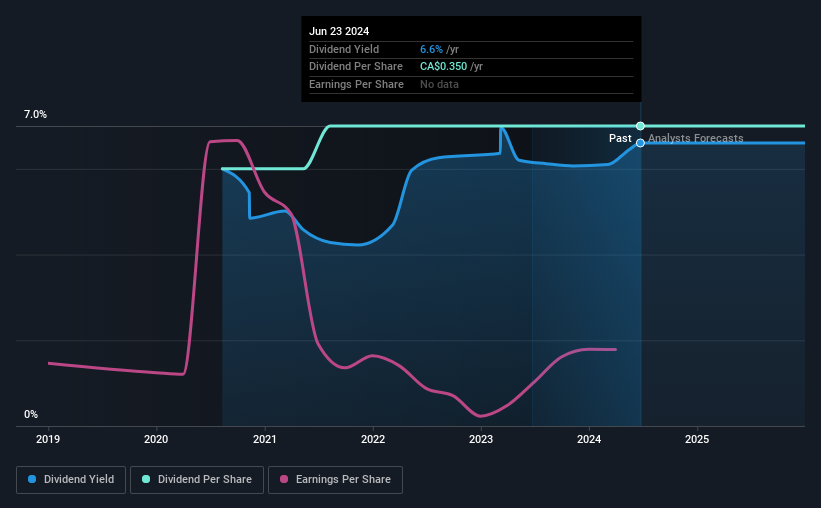Interested In Dexterra Group's (TSE:DXT) Upcoming CA$0.0875 Dividend? You Have Four Days Left
Dexterra Group Inc. (TSE:DXT) stock is about to trade ex-dividend in four days. The ex-dividend date is usually set to be one business day before the record date which is the cut-off date on which you must be present on the company's books as a shareholder in order to receive the dividend. The ex-dividend date is an important date to be aware of as any purchase of the stock made on or after this date might mean a late settlement that doesn't show on the record date. Accordingly, Dexterra Group investors that purchase the stock on or after the 28th of June will not receive the dividend, which will be paid on the 15th of July.
The company's next dividend payment will be CA$0.0875 per share, and in the last 12 months, the company paid a total of CA$0.35 per share. Based on the last year's worth of payments, Dexterra Group stock has a trailing yield of around 6.6% on the current share price of CA$5.30. Dividends are an important source of income to many shareholders, but the health of the business is crucial to maintaining those dividends. So we need to investigate whether Dexterra Group can afford its dividend, and if the dividend could grow.
See our latest analysis for Dexterra Group
Dividends are typically paid from company earnings. If a company pays more in dividends than it earned in profit, then the dividend could be unsustainable. Its dividend payout ratio is 86% of profit, which means the company is paying out a majority of its earnings. The relatively limited profit reinvestment could slow the rate of future earnings growth. We'd be worried about the risk of a drop in earnings. That said, even highly profitable companies sometimes might not generate enough cash to pay the dividend, which is why we should always check if the dividend is covered by cash flow. Thankfully its dividend payments took up just 40% of the free cash flow it generated, which is a comfortable payout ratio.
It's positive to see that Dexterra Group's dividend is covered by both profits and cash flow, since this is generally a sign that the dividend is sustainable, and a lower payout ratio usually suggests a greater margin of safety before the dividend gets cut.
Click here to see the company's payout ratio, plus analyst estimates of its future dividends.
Have Earnings And Dividends Been Growing?
Stocks in companies that generate sustainable earnings growth often make the best dividend prospects, as it is easier to lift the dividend when earnings are rising. If earnings fall far enough, the company could be forced to cut its dividend. This is why it's a relief to see Dexterra Group earnings per share are up 4.3% per annum over the last five years. A payout ratio of 86% looks like a tacit signal from management that reinvestment opportunities in the business are low. In line with limited earnings growth in recent years, this is not the most appealing combination.
Another key way to measure a company's dividend prospects is by measuring its historical rate of dividend growth. Dexterra Group has delivered an average of 3.9% per year annual increase in its dividend, based on the past four years of dividend payments. We're glad to see dividends rising alongside earnings over a number of years, which may be a sign the company intends to share the growth with shareholders.
Final Takeaway
Has Dexterra Group got what it takes to maintain its dividend payments? Earnings per share growth has been modest and Dexterra Group paid out over half of its profits and less than half of its free cash flow, although both payout ratios are within normal limits. Overall, it's not a bad combination, but we feel that there are likely more attractive dividend prospects out there.
On that note, you'll want to research what risks Dexterra Group is facing. To help with this, we've discovered 3 warning signs for Dexterra Group that you should be aware of before investing in their shares.
A common investing mistake is buying the first interesting stock you see. Here you can find a full list of high-yield dividend stocks.
Have feedback on this article? Concerned about the content? Get in touch with us directly. Alternatively, email editorial-team (at) simplywallst.com.
This article by Simply Wall St is general in nature. We provide commentary based on historical data and analyst forecasts only using an unbiased methodology and our articles are not intended to be financial advice. It does not constitute a recommendation to buy or sell any stock, and does not take account of your objectives, or your financial situation. We aim to bring you long-term focused analysis driven by fundamental data. Note that our analysis may not factor in the latest price-sensitive company announcements or qualitative material. Simply Wall St has no position in any stocks mentioned.
Have feedback on this article? Concerned about the content? Get in touch with us directly. Alternatively, email editorial-team@simplywallst.com

 Yahoo Finance
Yahoo Finance 
